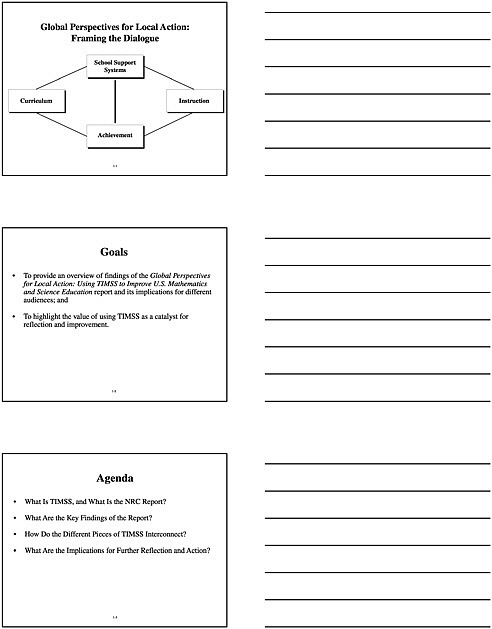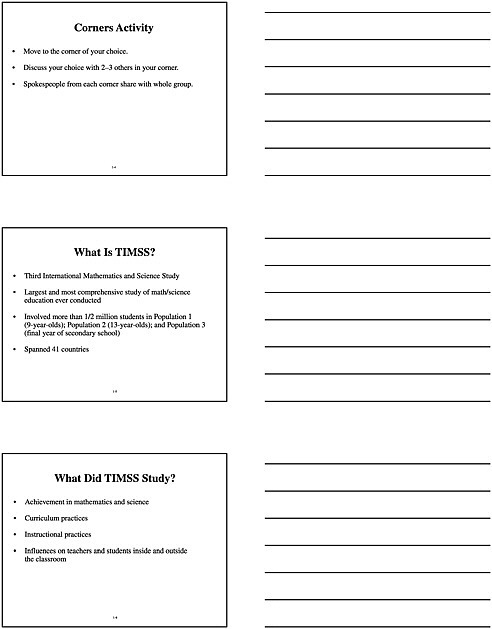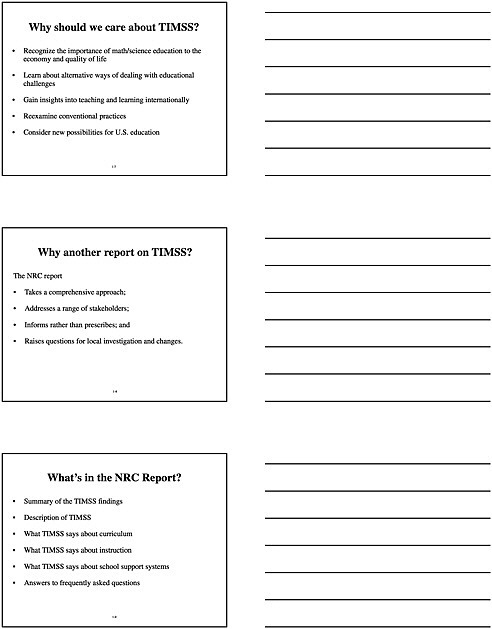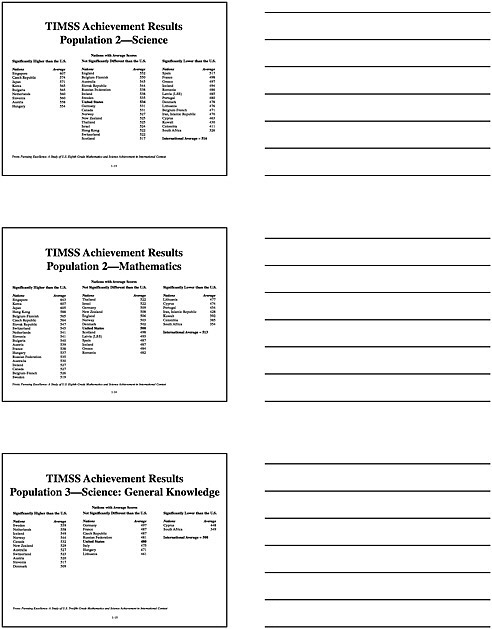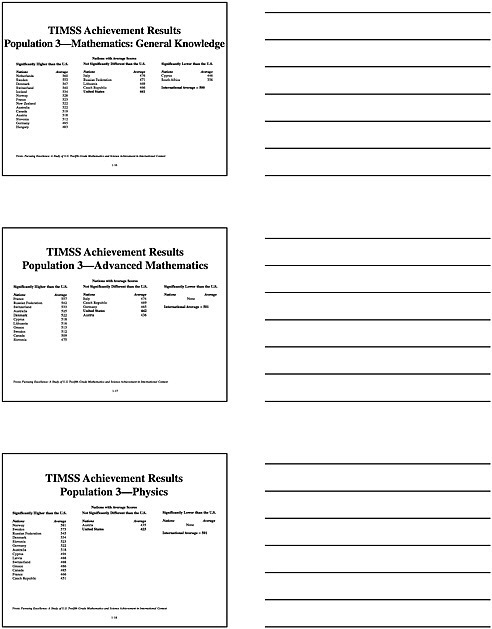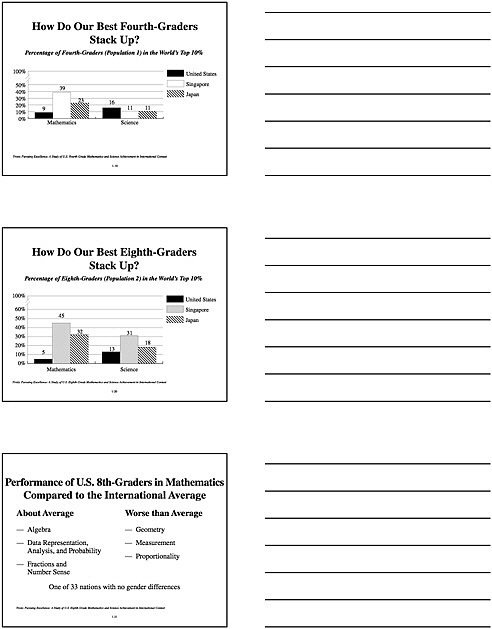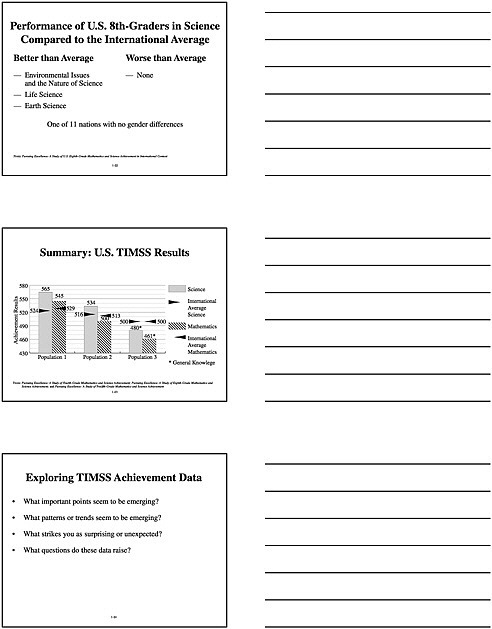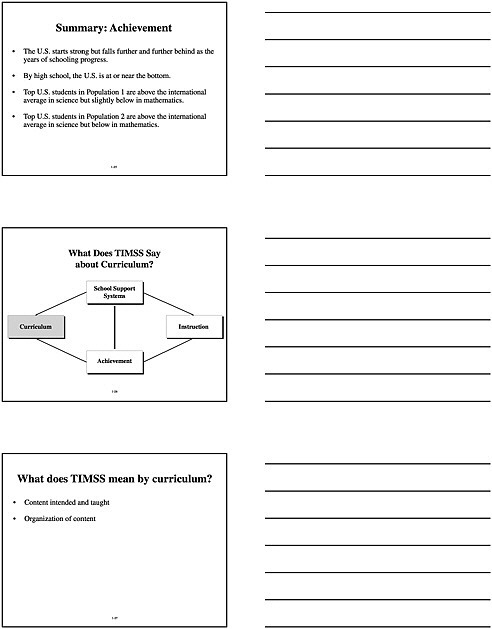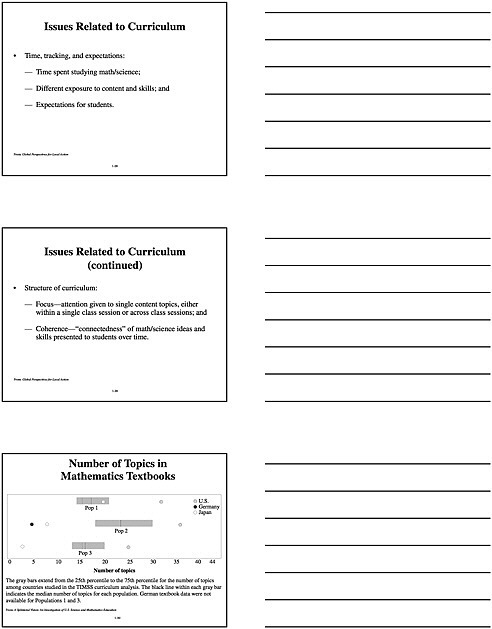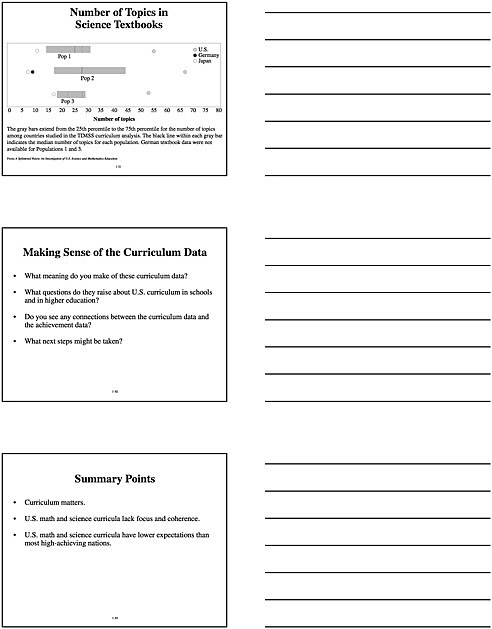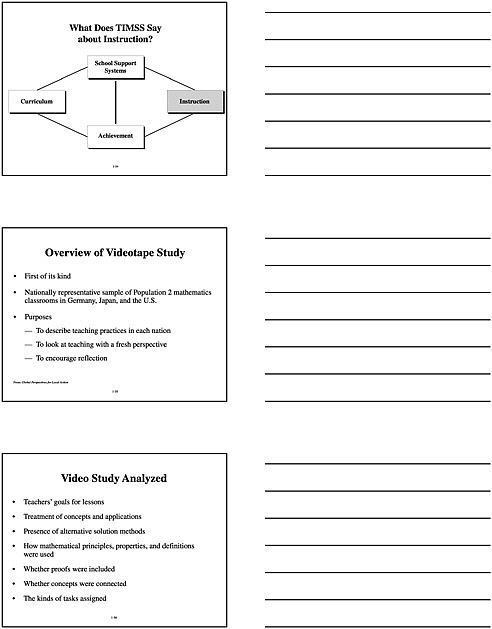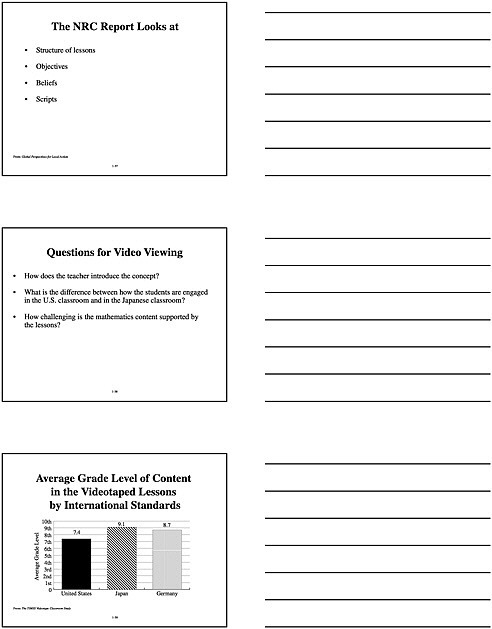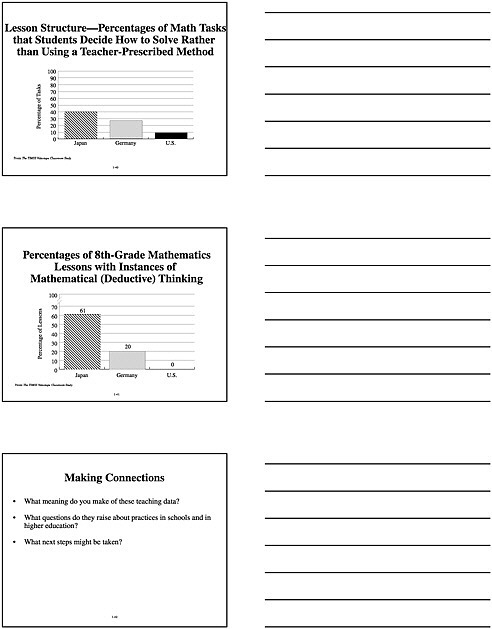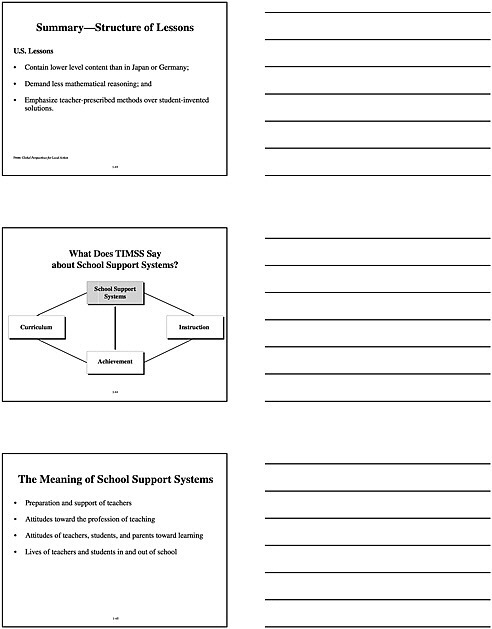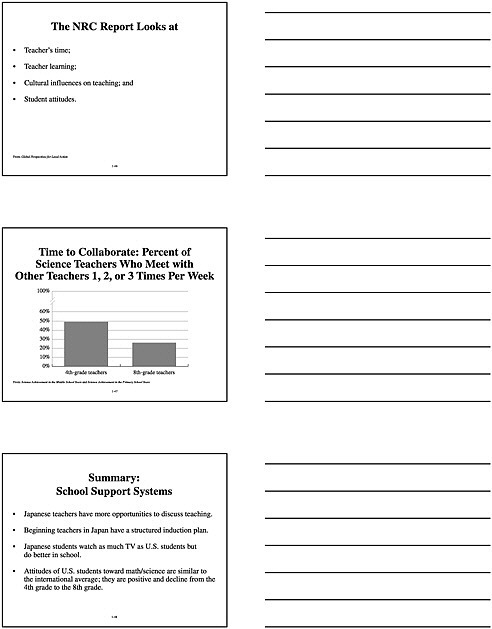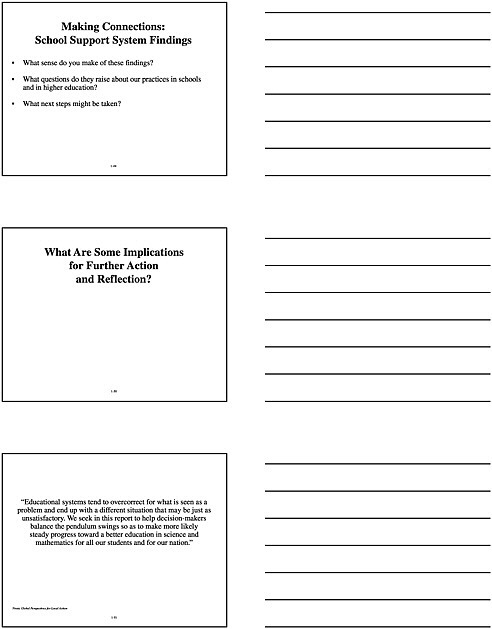ACTIONS TO IMPROVE MATHEMATICS AND SCIENCE EDUCATION
Actions that Teachers Can Take
Get to know the results from TIMSS.
Be cautious about jumping to conclusions about one aspect of the TIMSS findings—keep in mind the connections of curriculum, instruction, and school culture to overall student achievement.
Examine equity issues in your classroom.
Working with an existing school planning or improvement group, gather data to identify areas for improvement in mathematics and science learning, curriculum, instruction, and culture in your own school. Here are some possibilities for improvement:
-
Focus the curriculum by prioritizing curriculum topics and eliminating the low priorities.
-
Develop a curriculum framework based on the NCTM Standards and the National Science Education Standards that identifies where and how fundamental concepts and ideas are developed K–12.
-
Adopt new professional development strategies, such as teacher-led study groups for examining lessons.
-
Conduct textbook review and curriculum selection with TIMSS findings in mind.
-
Mentor new teachers.
-
Engage groups of teachers in micro-teaching lessons on the same topic.
-
Watch and discuss the TIMSS teacher videos with colleagues, then discuss and consider the different teaching alternatives shown.
-
Use data to examine, analyze, and improve instruction.
ACTIONS TO IMPROVE MATHEMATICS AND SCIENCE EDUCATION
Actions that Administrators Can Take
Learn what TIMSS found about mathematics and science instruction, curriculum, and school culture.
Watch and discuss the TIMSS teaching videos with other administrators and with teachers.
Work with existing school or district planning, accreditation, or improvement groups to investigate your own practices related to the TIMSS findings:
-
How do your own students’ performances compare with the U.S. findings?
-
Explore your curriculum—how focused and coherent is it?
-
Examine the instruction—how challenging is it?
-
Consider your school culture—how collegial is it?
Encourage/organize ongoing professional development in math/science.
Support teachers to make improvements in learning by providing time for learning and collegial exchanges.
Create a mentor program for beginning teachers in your school. Protect all teachers’ time so they have time to learn and reflect on practice.
ACTIONS TO IMPROVE MATHEMATICS AND SCIENCE EDUCATION
Actions that Higher Education Faculty Can Take
Develop a curriculum framework based on the NCTM Standards and the National Science Education Standards that identifies where and how fundamental concepts and ideas are developed K–12 and apply this framework within and across undergraduate mathematics and science programs and the teacher education program to increase focus and coherence. Examine whether the curriculum framework shows evidence of tracking or grouping of kinds of knowledge and explore the implications for prospective teachers.
Map out what kinds of mathematics and science content all teacher education students learn with your program. Explore the focus of this curriculum, its coherence, and the ways in which coherence exists between this disciplinary content and content related to instruction, such as methods, curriculum, and so on.
Help teacher education students learn the value of developing curriculum frameworks and topic tracing and engage them in doing this type of activity in the schools where they are observing or interning.
Examine the methods teaching faculty are using and explore alternatives. Share the TIMSS findings with schools in your area and in the clinical settings through which you prepare pre-service teachers and work with in-service educators.
Examine the ways and places in which your teacher education students learn about curricular tracking. Share TIMSS findings with students and brainstorm ways in which they could engage in similar activities.
Organize a series of faculty seminars/discussions to view TIMSS videotapes as an opportunity to begin a serious discussion about visions of teaching. Use this as an opportunity to reflect on your program’s shared visions of goals for teaching lessons, how content gets represented, and desired scripts for lessons. Consider undertaking a video study of instruction in schools in which you are engaged (as sites for student teaching or collaborative research) that could extend these discussions. Organize a seminar involving those most directly engaged in supporting field-based teacher education: university supervisors, collaborating teachers, and others. Together, explore the report’s discussions of preparation and support of teachers (and examine parts of the TIMSS case studies) to launch a discussion about assumptions undergirding your program about how beginning teachers learn best. Through discussion of TIMSS findings, examine how your program enacts its own “cultural” beliefs about teacher autonomy, the meaning of professional development, stages of teacher learning, and so on. Reflect on implications of this for who participates in supporting beginning teacher learning, the division of labor within that support community (of university and school people), and the allocation of time given teacher education students for learning in the field. Include the TIMSS findings in courses to help pre-service and in-service teachers explore the implications for their current or future instruction and curriculum planning.
ACTIONS TO IMPROVE MATHEMATICS AND SCIENCE EDUCATION
Actions that the Interested Public (Parents and Business and Community Leaders) Can Take
Be cautious of simplistic solutions to complex problems, such as student learning, when considering potentially useful suggestions, such as using computers and/or calculators and lengthening the school day.
Promote the use of data-driven decision making and become aware of what data might be locally useful and how it can be gathered and used. Ask questions such as, How do we know that? What is the data? Could there be another contributor to the problem that hasn’t been considered?
Support improvements in your local schools by efforts such as volunteering to find resources, bringing business or workforce perspectives into the schools, appreciating that time for professional development is needed, and remaining open to new ways of teaching and learning.
Make teachers and educational administrators in your community aware of the TIMSS findings.
Encourage existing planning and school improvement groups in your community to investigate the extent to which your schools’ actions reflect the TIMSS findings.
Fund and/or support the development and implementation of standards-based mathematics and science programs.
ACTIONS TO IMPROVE MATHEMATICS AND SCIENCE EDUCATION
Actions that State Education Department Staff Can Take
Use textbook adoption processes to analyze curriculum based on TIMSS and to make improvements in state-approved materials.
Review state curriculum frameworks for focus and coherence. Make adjust-ments to deepen the focus on key topics.
Support local educators in developing curriculum frameworks based on the NCTM Standards and the National Science Education Standards that identify where and how fundamental concepts and ideas are developed K–12. Do this providing resources and training in framework development.
Review policies on professional development to ensure that state funds that are provided to local sites can be used to support teacher time to collaborate, rather than just to support their participation in expert-led workshops.
Provide summaries of the TIMSS data to all schools in your state.
Create a lending library of TIMSS videos and other, related resources.
Groups of Students Studied in TIMSS
|
|
Ages |
Grade Levels in the U.S, |
|
Population 1 |
9-year-olds |
Grades 3 and 4 |
|
Population 2 |
13-year-olds |
Grades 7 and 8 |
|
Population 3 |
Final year of secondary school |
Grade 12 |
Module 1 Handout

